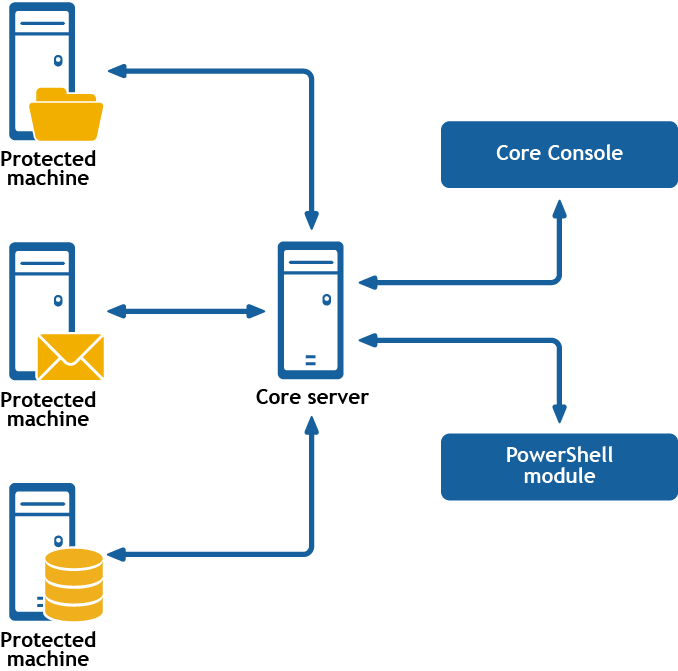When running on the same machine on which Rapid Recovery Core is installed, the Rapid Recovery Command Line Management utility bases its display language on the language set for the Rapid Recovery Core. In this release, supported languages include English, Chinese (Simplified), French, Korean, German, Japanese, Portuguese (Brazil), and Spanish.
If the Rapid Recovery Command Line Management utility is installed on a separate machine, English is the only language supported.
Rapid Recovery consists of several software components. Key components relevant to this topic include the following:
- The Rapid Recovery manages authentication for protected machines, schedules for transferring data for backup and replication, export to virtual machines, reporting, and bare metal restore (BMR) to similar or dissimilar hardware.
- The Rapid Recovery Agent is responsible for taking volume snapshots and for fast transfer of the data to the repository managed by the Core.
- The Rapid Recovery PowerShell Module is a Windows utility that lets users interact with the Core server by using Windows PowerShell® scripts. This module offers some of the same functionality that the Rapid Recovery Core Console graphic user interface (GUI) provides. For example, the Rapid Recovery PowerShell Module can mount Rapid Recovery recovery points or force a snapshot of a protected machine.
The PowerShell module interacts with the Rapid Recovery Core

PowerShell is a Microsoft .NET Framework-connected environment designed for administrative automation. This section describes the Rapid Recovery PowerShell module and the cmdlets administrators can use to script certain functions without interaction with the Rapid Recovery Core GUI.
 NOTE: You can also run PowerShell scripts as pre and post scripts. For more information and sample scripts, see Scripting.
NOTE: You can also run PowerShell scripts as pre and post scripts. For more information and sample scripts, see Scripting.
The Rapid Recovery PowerShell Module is automatically installed and registered when you install the Rapid Recovery Core. The module is installed in your Windows system directory in the path: [Environment.SystemDirectory]\WindowsPowerShell\v1.0\Modules\RapidRecoveryPowerShellModule. For example, for x86 or 32-bit OS, it is installed in C:\Windows\System32\WindowsPowerShell\v1.0\Modules\RapidRecoveryPowerShellModule. When using the module, run PowerShell as an Administrator, and then change the directory to the location of the module.
Before using the Rapid Recovery PowerShell module, you must have Windows PowerShell 2.0 or later installed. Due to new features introduced in PowerShell 3.0, including easier access to object properties, PowerShell Web access, and support for REST calls, Quest recommends using PowerShell 3.0 or later.
Note: Make sure to place the powershell.exe.config file in the PowerShell home directory; for example, C:\WindowsPowerShell\powershell.exe.config.
<?xml version="1.0"?>
<configuration>
<startup useLegacyV2RuntimeActivationPolicy="true">
<supportedRuntime version="v4.0.30319"/>
<supportedRuntime version="v2.0.50727"/>
</startup>
</configuration>



